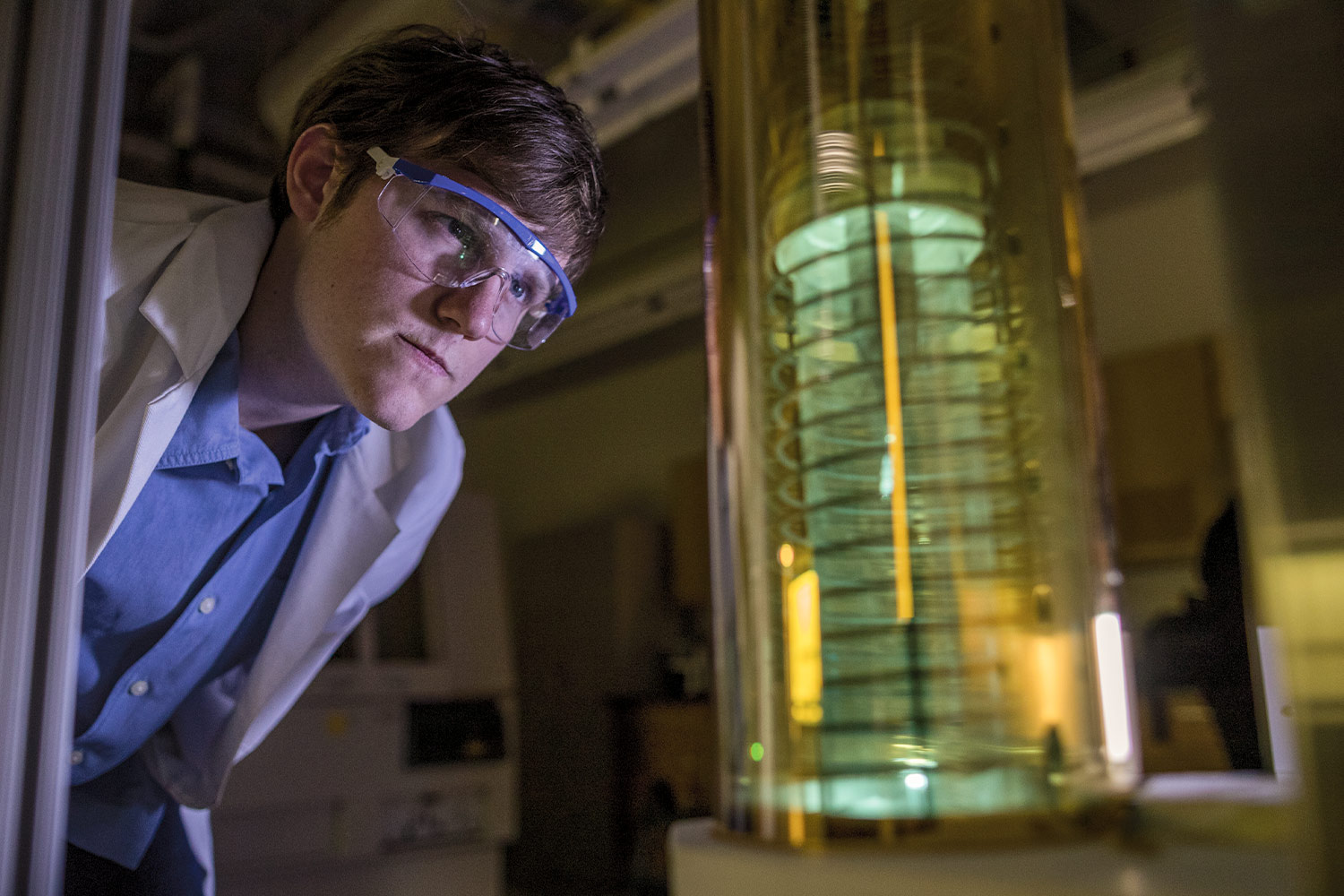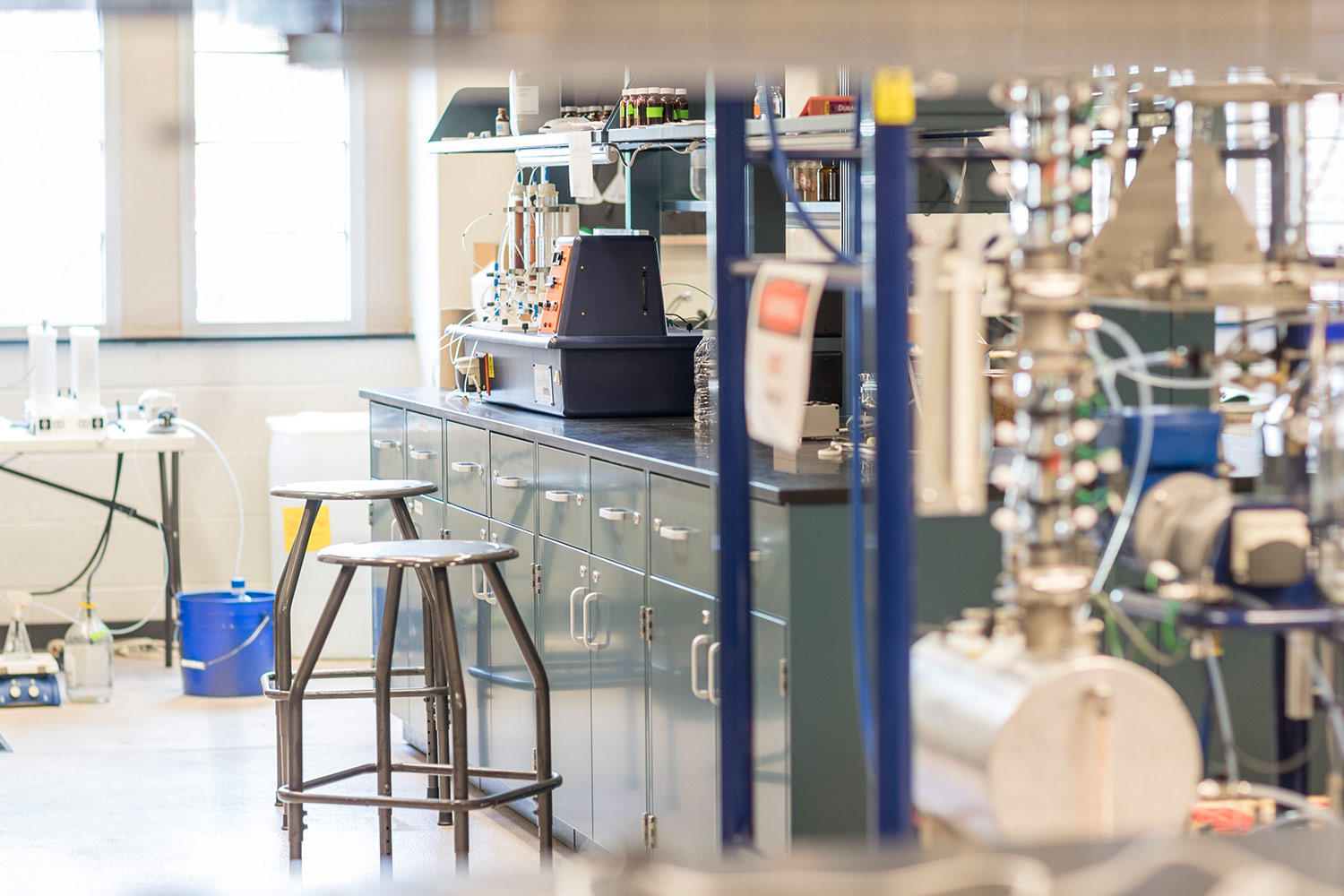Industry partners are one of the best allies a college of engineering can have. They can help ensure students are working on projects with impactful relevance to the real world, while also providing faculty opportunities to stay abreast of the latest trends and needs. They can also transform lab spaces, classrooms, and the campus itself. Here is a look at how two of the Tickle College of Engineering’s partners—Eastman and Siemens—have helped students apply learned theory through practice, supported faculty, and converted spaces for research and studying.

Bright Past, Shining Future
Siemens, SMRC Continue Crystal-Clear Vision for Growth
Radiation is something you can’t see, touch, or smell, but need to be able to detect. Scintillators are materials that give off photons of visible light when exposed to ionizing radiation, making it possible to detect, and making scintillators very useful across a wide variety of fields.
At UT, the Scintillation Materials Research Center (SMRC) has been on the cutting edge of research and development of such materials for many years and has become internationally known for its discoveries of novel scintillators in the form of single crystals, thin films, and polycrystalline ceramics.
SMRC’s origins date back to CTI Molecular Imaging, a company founded by UT engineering graduates that was a leading provider of PET and CT scanners for medical use. Siemens Medical Imaging bought CTI in 2005 and, in a joint partnership with UT, created SMRC.
Since its creation, Siemens has provided SMRC more than $7 million in funding as well as in-kind gifts of technology and software. More than 20 graduate students and over 40 undergraduates have benefitted from research experiences and positions with SMRC made possible in part by Siemens’ investment.
Scintillators are critical to PET and CT scanner technology, according to SMRC Director Chuck Melcher, who also holds research faculty appointments in the Departments of Materials Science and Engineering and Nuclear Engineering.
“PET and CT scanners only perform as well as the scintillators within them,” Melcher explained. “So, continuing to improve upon them is a key development for patients around the world.”
In addition to the technological benefits to Siemens and the medical imaging community, the partnership has focused heavily on student success. Numerous engineering students have graduated with valuable skills gained from their experience working at SMRC.
Harold Rothfuss (PhD/MSE, ’13), now a key scientist at Siemens, took part in several research breakthroughs related to cooping, or fine-tuning, in a sense, of crystals while working with the SMRC.
Former graduate research assistant Camera Foster (PhD/MSE, ’19), also worked with Siemens as part of her research into scintillation and luminescence while at UT.
“Working closely with Siemens taught me a great deal about the scintillator field,” she said. “It was unique because it highlighted the benefits of research on a university level as well as how that research directly impacts industry.”
Matthias Schmand, vice president of research and development at Siemens, served on Foster’s dissertation committee.
A new development at UT has further strengthened the connections between SMRC and the medical field with the launch of the Department of Nuclear Engineering’s medical physics program. Everett Cavanaugh, a master’s student supported by Siemens working in the SMRC, is part of the program’s inaugural class.
“We’re obviously proud of the contribution we can make on the education side, and Siemens has been a steadfast supporter of both education and research,” said Melcher. “It has been an extraordinarily successful partnership.”
If past success is any indication, the future potential of the Siemens-UT partnership seems crystal clear.
A Crystal Anniversary
Now, in its 15th “crystal anniversary” year, the center shows no signs of slowing down. SMRC and its researchers have recently won several awards and gained recognition from the scientific community:
- Assistant Professor Mariya Zhuravleva (MSE) was the recipient of a 2019 NSF Early CAREER Award
- Graduate student Daniel Rutstrom (NE) won a Nuclear Energy University Program Graduate Fellowship in 2019 and a 2020 Innovations in Nuclear Technology R&D Award, both from the US Department of Energy
- Undergraduate student Ian Greeley (MSE) was named a 2019 Goldwater Scholar, among the most prestigious undergraduate STEM scholarships in the US
- Assistant Research Professor Yuntao “Jeffery” Wu (MSE) received a prestigious IEEE 2017 Radiation Instrumentation Early Career Award
- Professor Melcher (MSE) was elected to the IEEE NPSS Nuclear Medical Imaging Steering Committee in 2018
- Zhuravleva and Research Associate Merry Koschan (SMRC) were elected as president and secretary, respectively, to the American Association for Crystal Growth
- SMRC faculty and staff have been invited to speak at conferences across the globe, including in Japan, Germany, and India.

Lab Partners
Eastman, UT Share History of Success
Now celebrating its 100th anniversary, Eastman has grown to become a Fortune 500 company, one of East Tennessee’s largest employers, and a key partner and collaborator with UT and the Tickle College of Engineering.
The last decade alone has brought many successful ventures between Eastman and the college, impacting faculty, students, and spaces on campus.
Eastman comes to campus
Since 2015, UT has been a proud member of the Eastman Innovation Network. The partnership is focused on conducting collaborative research in multiple scientific disciplines, especially in the neutron science and additive manufacturing fields in which UT is recognized worldwide for its expertise. Now in 2020, Eastman is set to expand the partnership by establishing an on-campus presence.
Eastman’s External Innovation Manager and Computational Chemist Brendan Abolins is moving into a space off Chapman Drive on the campus of the Institute of Agriculture, where he will help coordinate current efforts related to advanced materials, the Center for Renewable Carbon, and research at Cherokee Farm, as well as new initiatives.
“Eastman utilizes university partnerships to inform and accelerate our progress in strategic areas through open innovation and collaboration with faculty and students,” said Eastman’s Global External Innovation Manager Dawn Mason. “We are very excited to expand our relationship with the University of Tennessee by occupying a space on campus that will strengthen the work and mutually beneficial connections between the university and Eastman. Brendan will serve as our consistent presence on campus, spending time with faculty and students in a variety of ways.”
It’s just the most recent mutually-beneficial development in a relationship built off such arrangements; one poised to thrive for years to come.
Bolstering faculty, research
In the Department of Chemical and Biomolecular Engineering (CBE), Prados Professor Gila Stein and Ferguson Faculty Fellow Cong Trinh are also working with Eastman.
Stein is heading a team that includes CBE Associate Professor Manolis Doxastakis and Department of Chemistry Associate Professor Brian Long and is focused on developing new ways of producing polymers, while Trinh is working on making the production of chemical building blocks more sustainable and economical.
This collaborative work will allow them to be involved in interesting research while also helping their graduate students prepare for careers through work on real-world engineering problems, all while helping Eastman solve their particular needs.
Both projects have the potential to make a major impact in some of the fields where Eastman is an industry and thought leader, further highlighting how university research programs can align with corporate partners for the benefit of not only faculty and students, but society as a whole.
“This is a shining example of what is possible through corporate-college partnerships, said CBE Department Head Bamin Khomami. “The importance of having impactful access to projects in a way that helps faculty test and expand their knowledge, gives students the opportunity to learn in a hands-on way that cements what they’ve learned in the classroom, and benefits Eastman at the same time is something that can’t be overstated.”
Transformed spaces
Perhaps the most permanent, concrete example of the impact Eastman has had on UT was the complete overhaul of a pair of spaces within the Nathan W. Dougherty Engineering Building in 2015. The Eastman Unit Operations Laboratory was borne out of the remnants of a well-worn lab space on the ground floor of the building.
Eastman helped give the space new life while at the same time providing a mock-up version of an industrial lab, where students can run any number of experiments of importance to chemical and biomolecular engineering.
Students who spend time working in the lab gain the kind of hands-on experience of taking raw materials and turning them into the desired final product, which, in turn, gives companies like Eastman a pool of potential recruits who have gone through the production process in a practical, not just theoretical, way.
“Being able to provide students this sort of experience not only enhances their educational process, it also gives them an advantage when trying to find employment after graduation,” said Khomami.
In addition to the lab space, Eastman helped fund the creation of a new student-focused room within Dougherty to provide places for study and relaxation between classes.